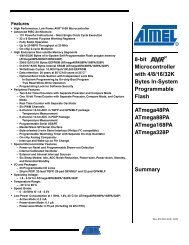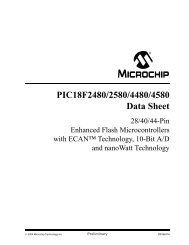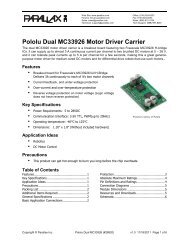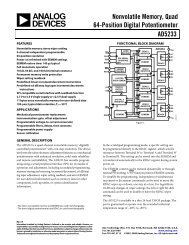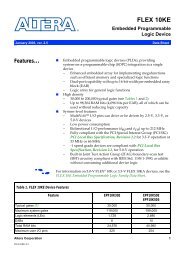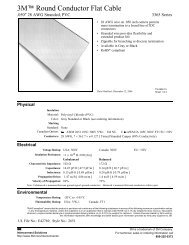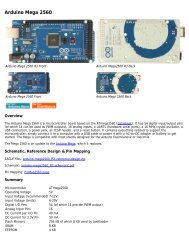Create successful ePaper yourself
Turn your PDF publications into a flip-book with our unique Google optimized e-Paper software.
<strong>Relays</strong> & Sockets<br />
Operating Instructions<br />
Terminal Blocks<br />
Timers<br />
<strong>Relays</strong> & Sockets<br />
Display Lights<br />
Switches & Pilot Lights<br />
Driving Circuit for <strong>Relays</strong><br />
1. To ensure correct relay operation, apply rated voltage to the relay coil.<br />
2. Input voltage for the DC coil:<br />
A complete DC voltage is best for the coil power to make sure of stable relay<br />
operation. When using a power supply containing a ripple voltage, suppress<br />
the ripple factor within 5%. When power is supplied through a rectifi cation<br />
circuit, the relay operating characteristics, such as pickup voltage and dropout<br />
voltage, depend on the ripple factor. Connect a smoothing capacitor for better<br />
operating characteristics as shown below.<br />
Smoothing<br />
Capacitor<br />
+<br />
R<br />
–<br />
Relay<br />
Pulsation<br />
Emin Emax Emean DC<br />
Emax – Emin<br />
Ripple Factor (%) × 100%<br />
Emean<br />
Emax = Maximum of pulsating current<br />
Emin = Minimum of pulsating current<br />
Emean = DC mean value<br />
3. Leakage current while relay is off:<br />
When driving an element at the same time as the relay operation, special<br />
consideration is needed for the circuit design. As shown in the incorrect<br />
circuit below, leakage current (Io) fl ows through the relay coil while the relay<br />
is off. Leakage current causes coil release failure or adversely affects the<br />
vibration resistance and shock resistance. Design a circuit as shown in the<br />
correct example.<br />
Incorrect<br />
R<br />
Io<br />
TE<br />
Correct<br />
4. Surge suppression for transistor driving circuits:<br />
When the relay coil is turned off, a high-voltage pulse is generated, causing a<br />
transistor to deteriorate and sometimes to break. Be sure to connect a diode<br />
to suppress the back electromotive force. Then, the coil release time becomes<br />
slightly longer. To shorten the coil release time, connect a Zener diode<br />
between the collector and emitter of the transistor. Select a Zener diode with<br />
a Zener voltage slightly higher than the power voltage.<br />
Back emf<br />
suppressing diode<br />
+<br />
R Relay<br />
–<br />
R<br />
Protection for Relay Contacts<br />
1. The contact ratings show maximum values. Make sure that these values are<br />
not exceeded. When an inrush current fl ows through the load, the contact<br />
may become welded. If this is the case, connect a contact protection circuit,<br />
such as a current limiting resistor.<br />
2. Contact protection circuit:<br />
When switching an inductive load, arcing causes carbides to form on the<br />
contacts, resulting in increased contact resistance. In consideration of contact<br />
reliability, contact life, and noise suppression, use of a surge absorbing circuit<br />
is recommended. Note that the release time of the load becomes slightly<br />
longer. Check the operation using the actual load. Incorrect use of a contact<br />
protection circuit will adversely affect switching characteristics. Four typical<br />
examples of contact protection circuits are shown in the following table:<br />
RC<br />
Diode<br />
Varistor<br />
Power<br />
Power<br />
+<br />
Power<br />
–<br />
Power<br />
C<br />
R<br />
C<br />
R<br />
D<br />
Varistor<br />
Ind. Load<br />
Ind. Load<br />
Ind. Load<br />
Ind. Load<br />
This protection circuit can be used when the load<br />
impedance is smaller than the RC impedance in an<br />
AC load power circuit.<br />
• R: Resistor of approximately the same resistance<br />
value as the load<br />
• C:0.1 to 1 μF<br />
This protection circuit can be used for both AC and<br />
DC load power circuits.<br />
R: Resistor of approximately the same resistance<br />
value as the load<br />
C: 0.1 to 1 μF<br />
This protection circuit can be used for DC load power<br />
circuits. Use a diode with the following ratings.<br />
Reverse withstand voltage: Power voltage of the<br />
load circuit x 10<br />
Forward current: More than the load current<br />
This protection circuit can be used for both AC and<br />
DC load power circuits.<br />
For a best result, when using a power voltage of 24<br />
to 48V AC/DC, connect a varistor across the load.<br />
When using a power voltage of 100 to 240V AC/DC,<br />
connect a varistor across the contacts.<br />
3. Do not use a contact protection circuit as shown below:<br />
C<br />
Power<br />
C<br />
Power<br />
Load<br />
Load<br />
This protection circuit is very effective in arc suppression when<br />
opening the contacts. But, the capacitor is charged while the<br />
contacts are opened. When the contacts are closed, the capacitor<br />
is discharged through the contacts, increasing the possibility of<br />
contact welding.<br />
This protection circuit is very effective in arc suppression when<br />
opening the contacts. But, when the contacts are closed, a current<br />
flows to charge the capacitor, causing contact welding.<br />
Generally, switching a DC inductive load is more diffi cult than switching a DC<br />
resistive load. Using an appropriate arc suppressor, however, will improve the<br />
switching characteristics of a DC inductive load.<br />
Soldering<br />
Circuit Breakers<br />
1. When soldering the relay terminals, use a soldering iron of 30 to 60W, and<br />
quickly complete soldering (within approximately 3 seconds).<br />
2. Use a non-corrosive rosin fl ux.<br />
Clearwater Tech - Phone: 800.894.0412 - Fax: 208.368.0415 - Web: www.clrwtr.com - Email: info@clrwtr.com



